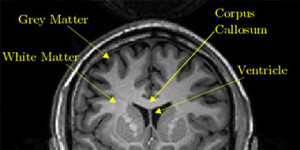How To Repair White Matter In The Brain
 White vs. Grayness Affair Injury
White vs. Grayness Affair Injury
Encephalon damage is often described as either a white or grey affair injury, but what is the difference?
White Affair Injuries
White thing injuries occur when white matter tracts (bundles of myelinated axons) are damaged. Harm essentially cuts off or limits communication betwixt areas of greyness thing (neuron jail cell bodies and dendrites, the neuropil, glial cells, and capillaries).
Mayhap the easiest example to envision is a spinal string injury.
The exterior of the spinal string is composed of big white matter tracts. Transecting or compressing these tracts tin can lead to paralysis because the information from the encephalon's motor cortex (grey matter) tin can no longer accomplish the spinal cord and muscles. White matter tracts relaying sensory data from the muscles and skin to the brain tin can also be lost. In this example, the patient may not be able to feel an ice cube placed on his or her pare.
White affair injuries are very serious, just, depending on the type and extent of the injury, extensive recovery may occur. Every bit long equally the neuron cell bodies remain healthy, axons can regrow and slowly repair themselves. Functional recovery may also occur if the information can be transmitted through an alternative route. In many cases, this occurs through the strengthening of weak connections that already exist.
Grey Matter Injuries
Neuronal death is at the heart of grey matter brain damage.
The neuron cell bodies are responsible for keeping the entire neuron alive and good for you and that takes a lot of free energy. Grey matter is therefore very susceptible to injury when oxygen levels are low (hypoxia) such as during an ischemic event.
Damage likewise occurs when the local surroundings changes such as during an intracerebral hemorrhage or when concrete damage occurs. Damaged neurons and glia also release factors that can increase the effect of the injury. In many cases, the initial damage causes a series of downstream effects that can initiate apoptosis (programmed jail cell decease).
Once the impairment has occurred, the cell cannot support its axons or dendrites and the unabridged cell dies. This is especially truthful in neurons that have big jail cell bodies and long axons. In contrast, after a white matter injury, a salubrious prison cell body may be able to repair the damaged axon.
Similar white affair injuries, the type and extent of the injury largely dictate recovery.
Young infants and children frequently have improve outcomes than adults since their neural systems are still developing and more than adjustable. Targeted rehabilitation preparation can also meliorate functional outcomes. For instance, later selective damage to the motor cortex, fine finger movements tin can be improved when the rehabilitative training results in an expansion of the finger motor representation within the motor cortex. In other words, nearby neurons tin can begin to take over the functions of the damaged neurons.
White and Gray Thing Interactions
Although white and grey matter injuries are often presented every bit separate entities, information technology is hard to take one without the other.
This is because (1) many injuries simply involve both greyness and white matter areas, (2) a single neuron can have its cell torso and dendrites in the grey thing and an axon in the white thing, and (3) because neurons depend on their interactions with other neurons.
White matter damage can crusade a swell deal of stress and increment the energy demands on the neuron. In some cases, the neuron will non exist able to see the energy demands and the unabridged neuron will die (prison cell body, axon, and dendrites). This often starts with the retraction of the injured axon.
On the other cease, the grey matter targeted past that axon (i.e. the post-synaptic neurons) can shrink and die from inactivity or be taken over by other functions (i.east. innervated by other neurons). Grey thing nearly the site of white thing injury tin also exist damaged by factors released from damaged axons and vice versa.
Source: https://www.hydroassoc.org/grey-matter-brain-damage/

0 Response to "How To Repair White Matter In The Brain"
Post a Comment